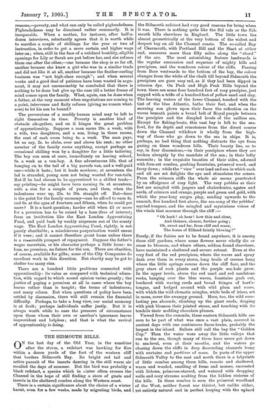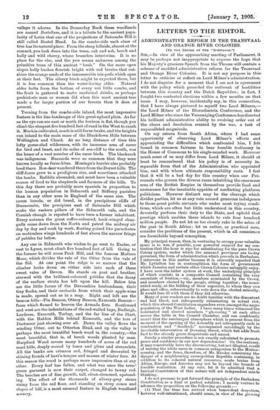O N the last day of the Old Year, in the
sunshine after the storm, a redstart was hawking for flies within a dozen yards of the foot of the western cliff that borders Sidmouth Bay. Its bright red tail and active pursuit of the insects dancing in the still warm air recalled the days of summer. But the bird was probably a black redstart, a species which in winter often crosses the Channel in the hope of still finding a store of gnats and insects in the sheltered combos along the Western coast.
There is a certain significance about the choice of a winter haunt, even for a few weeks, made by migrating birds, and
the Sidmouth redstart had very good reasons for being where it was. There is nothing quite like the Sid vale or the Sid. month hills elsewhere in England. The little town lies almost geometrically at the very bottom of the widest and deepest bay on all the Channel coasts. The so-called Bay of Charmouth, with Portland Bill and the Start at either end, measures more than fifty miles along the "chord" of the arc. The most astonishi g feature landwards is the regular succession and sequence of mighty hills and precipices, and the wondrous colour of the cliffs. Passing from Bere westwards to the bottom of the bay, the colour changes from the white of the chalk till beyond Sidmouth the precipices are pure rosy red, as if they had been dipped in crimson dye. On Peak and High Peak Hills beyond the town there are some four hundred feet of rosy precipice, just capped with a trifle of a hundred feet of yellow sand and clay. The heaving waters of the lower Channel, touched with the tint of the blue Atlantic, bathe their feet, and when the morning sun glows upon their faces the reflection on the waves beneath paints a broad belt of Royal purple between the precipice and the dimpled levels of the sadness sea. Except for fishing-boats, this vast bay is left to the sea- fowl, for its depth and remoteness from the direct course down the Channel withdraw it wholly from the high- way of those who go down to the sea in ships. It is
perhaps, no bad thing that nothing distracts the eye from gazing on these wondrous hills. Their beauty lies, so to say, in four dimensions,—in their precipices where they are broken abruptly by the mandate of the sea ; in their lofty summits ; in the exquisite beauties of their sides, adorned with fern-set combes, gushing fountains, primeval wood, and furzy down ; while the " view " over land and sea in which each and all are set delights the eye and stimulates the senses.
From the crimson cliffs the whole air seems penetrated by an effulgence of rosy light. The very pebbles at their feet are mingled with jaspers and chalcedonies, agates and Bards, of crimson and orange, purple and green and gold, with 'which the year-long surges play, sending upwards to the summit, five hundred feet above, the sea-song of the pebbles' myriad tongues, and the mingled and mysterious voices of the winds that murmur through the cliff :—
" Oh hark ! oh hear ! how thin and clear, And thinner, clearer, further going; Oh, sweet and far, from cliff and scam, The horns of Elfland faintly blowing !"
Surely, if the fairies are to be found anywhere, it is among these cliff gardens, where some flowers never wholly die or cease to blossom, and where others, seldom found elsewhere, have maintained a sheltered and secure retreat. Even at the very foot of the red precipices, where the waves and spray dash over them in every storm, long trails of creases hang where the little springs course down the cliff face, and the grey stars of rock plants and the purple sea-kale grow. In the upper levels, above the red marl and red sandstone rocks, hanging over the blue waves, fountains gush out, bordered with waving reeds and broad fringes of hart's- tongue, and hedged around with wild plum and roses, with which the wild clematis mingles, while beds of irises, set in moss, cover the swampy ground. Here, too, the wild ever- lasting pea abounds, climbing up the giant reeds, draping with pink blossom their jointed stems, and touching with its tendrils their nodding chocolate plumes.
Viewed from the summits, these eastern Sidmouth hills are seen to be part of what was once a vast plain, covered in ancient days with one continuous furze-brake, probably the largest in the island. Sailors still call the bay the "Golden Cup." Then the water wore away the little valleys that run to the sea, though many of them have never got down to sea-level, even at their mouths, and the waters go chasing down the cliffs in deep descending channels hung with curtains and portieres of moss. In parts of the upper Sidmouth Valley to the east and north there is a labyrinth of little combes among these hills, remote and sheltered, warm and wooded, smelling of ferns and mosses, encrusted with lichens, primrose-starred, and watered with dropping wells and oozy streams soaking from the hidden cisterns of the hills. In these combos is seen the primeval woodland of the West, neither forest nor thicket, but unlike either, vet entirely natural and in perfect keeping with the upland valleys it adorns. In the Domesday Book these woodlands are named Bostellum, and it is a tribute to the ancient popu- larity of Latin that one of the projections of Salcombe Hill is still called Boatel Head. In the combe-side each class of tree has its natural place. From the steep hillside, almost at the summit, you look down into the trees, oak and ash, beech and holly and wild cherry, whose branches intertwine. It is no place for the elm, and the yew seems unknown among the primitive trees of this ancient "bush." On the more open slopes holly bushes flourish bright with red berries that out- shine the orange seeds of the innumerable iris-pods which open at their feet. The silvery birch might be expected there, but it is less common than the water-loving alder. Natural alder holts form the bottom of every wet little combe, and the fruit is gathered to make medicinal drinks, as perhaps prehistoric man or woman did when this most ancient tree made a far larger portion of our forests than it does at present.
Turning from the combe-side inland, the most impressive feature is the line-landscape of this great upland plain. As far as the eye can see east or north the horizon is flat, though you climb the steepest five hundred feet of road in the West to reach it. Much is cultivated, much is still furze-brake, and the heights run inland to the main mass of the Blackdown Hills between Wellington and Chard. At no long distance of time this lofty gorse-clad wilderness, with its immense area of cover for bird and beast, and its miles of sea-cliff to the south, was the home of a vast number of the rarer birds. The blackcock was indigenous. Buzzards were so common that they were known locally as furze-kites Montagu's harrier also probably bred there. Roe-deer wandered there from the Dorset hills. The cliff-foxes grew to a prodigious size, and sometimes attacked the lambs. Rabbits abounded, and must have been a valuable source of food to the shepherds and farmers of the hills. To this day there are probably more spaniels in proportion to the human population in Sidmouth and Sidbury parishes than in any other area in England of the same size. The raven breeds, or did breed, in the precipitous cliffs of Dunscombe, the precipices east of Salcombe Hill which make the eastern pillars of the Sidmouth vale, and the Cornish chough is reputed to have been a former inhabitant Every autumn the great coffee-coloured, hook-winged skua- gulls come down from the North and patrol the midway air day by day and week by week, floating poised like parachutes on motionless wings hundreds of feet above the narrow fringe of pebbles far below.
Any one in Sidmouth who wishes to go west to Exeter, or east to Lyme, must climb five hundred feet of hill. Going to the former he will cross Peak Hill, and the famous Mutters Moor, which divides the vale of the Otter from the vale of the Sid. At one point the ridge is so narrow that the climber looks down on either side into each of these sweet vales of Devon. He stands on peat and heather, strewed with the brilliant-coloured pebbles that the decay of the surface strata has left upon the hill. Below him are the little farms of the Devonshire husbandmen, their tiny flocks, and their orchards from which their apple-wine is made, spread out as in a map. Right and left are the beacon hills—Pin Beacon, Ottery Beacon, Exmouth Beacon— from which flamed to heaven the Armada fires. Southward and west are the indentations of the red-walled bays, Budleigh, Lardram, Exmouth, Torbay, and the far line of the Start, with the Radon Hills behind Exmouth, and the ton of Dartmoor just showing over all. Down the valley flows the winding Otter, out to Otterton Head, and up the valley is perhaps the most beautiful beech wood in the country,---the most beautiful, that is, of beech woods planted by man. Harpford Wood covers many hundreds of acres of the red marl hills, deeply scored by lanes and glens and streamlets. All the banks are crimson red, fringed and decorated by shining fronds of hart's-tongue and masses of winter fern. At this season the wood is perhaps more impressive than at any other. Every leaf has fallen, and what was once the treee green garment is now their carpet, changed to tawny red. The beeches are of fine growth, tall, clean-stemmed, upstand- ing. The effect of the thousands of silvery-grey stems rising from the red floor, and standing on steep cones and slopes of hill, is a most unusual feature in English woodland scenery.















































 Previous page
Previous page